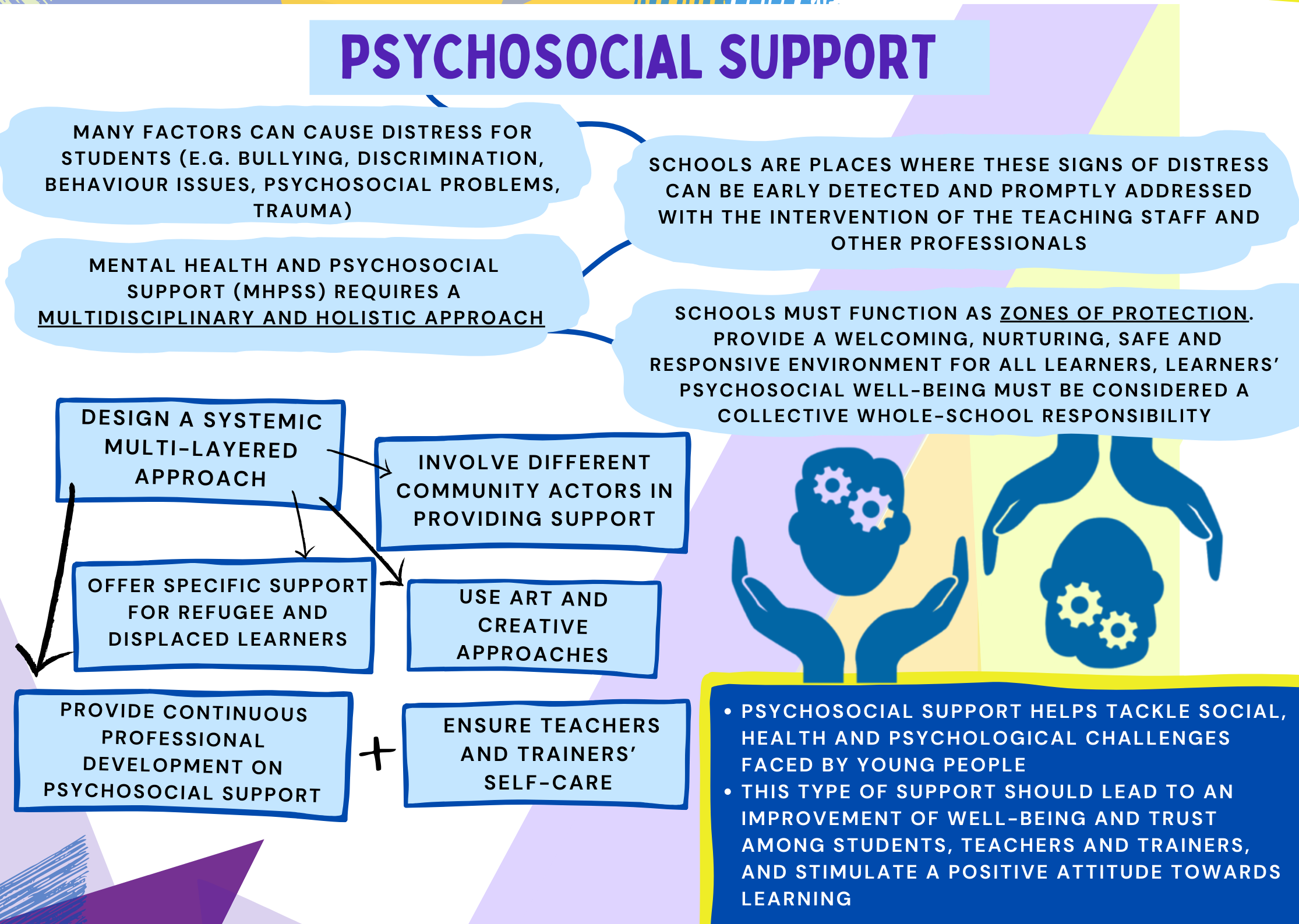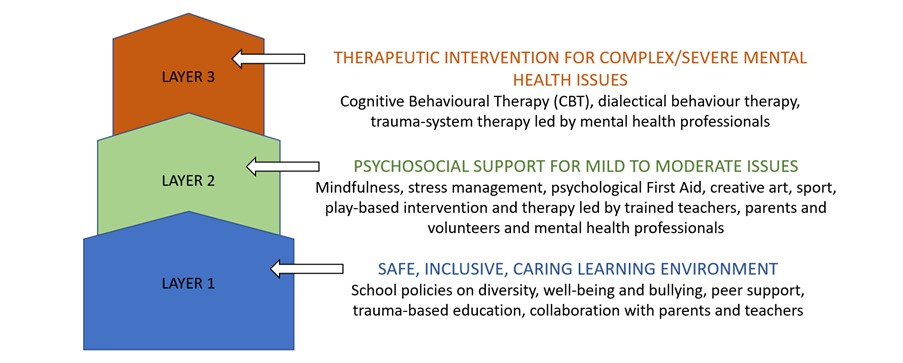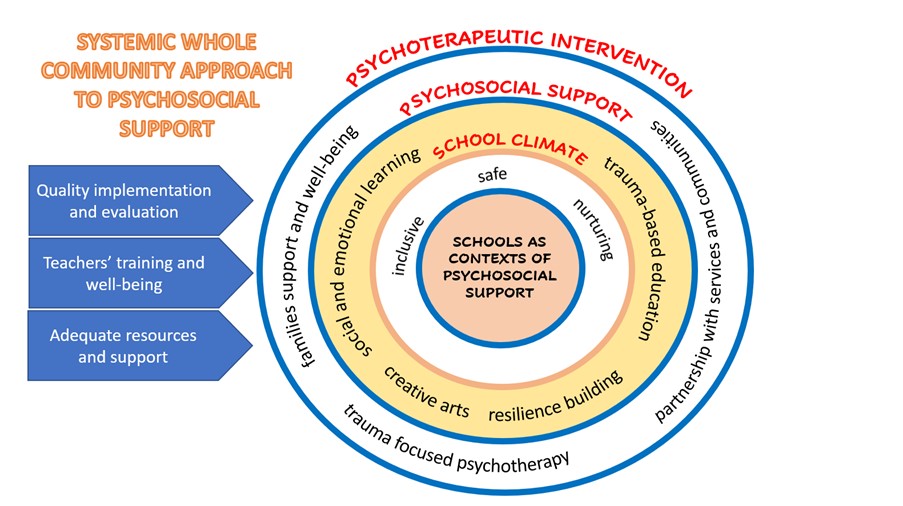Problem statement
Mental health and well-being are among the first factors influencing students’ education trajectory and determine school success or failure.
Early leaving from VET can be caused by health issues, psychosocial problems, or experiences of trauma which are not handled with appropriate care and attention. For this reason, it is important to develop modern methods and approaches to provide students with effective psychosocial support throughout the educational process.
Two recent factors that have strongly impacted on learners’ well-being on a larger scale in Europe are Covid-19 and the arrival of many Ukrainian refugees in schools of other European countries. To tackle the profound consequences that these circumstances have left on young people, a multi-layered psychosocial support is needed more than ever, both for students and for teachers and trainers facing such difficult circumstances.
This necessity entails a wide range of further challenges that VET must address, such as how to coordinate psychosocial support at different system levels; how to understand the scale and nature of needs; and how to identify whether these are being met through monitoring and evaluation; how to equip teachers, trainers and other professionals to provide culturally and linguistically meaningful interventions; and how to foster learners’ well-being inside and outside the learning environment.

Beneficiaries
Addressing the problem
Building on the forthcoming European guidelines to support the inclusion of displaced Ukrainian students, psychosocial support stands as one of the main pillars to respond to the challenge education and training institutions are facing in integrating both Ukrainian learners and teachers in host countries. To achieve this aim multiple approaches, practices and tools can be adopted, such as social and emotional learning (SEL), resilience-building, trauma-based education, mutual understanding, constructive conflict resolutions. Mental Health and Psychosocial Support (MHPSS) requires a multidisciplinary and holistic approach envisaging consistency and coordination of actions.
There are many factors, external and school-related, that can cause distress for a student. Teachers and trainers are often called to confront difficult situations related to bullying and discrimination, to behaviour issues or to adaptation challenges that students might face when settling in a new cultural and linguistic environment. Schools are places where these signs of distress can be early detected and promptly addressed with the intervention of the teaching staff and other professionals. Moreover, based on Cedefop findings, students and their families prefer interventions to be delivered at VET settings (schools and the workplace) rather than in clinics, as these are often more accessible and less stigmatising.
For these interventions to be effective and to provide appropriate psychosocial support, schools must function as zones of protection. VET institutions need to provide a welcoming, nurturing, safe and responsive environment for all learners, creating a positive and inclusive school climate for each of them. Learners’ psychosocial well-being must be considered a collective whole-school responsibility, and teachers and trainers should be well prepared to support all learners to address their academic and behaviour challenges.
The following tips are given as advice to policy makers and VET practitioners involved in the design and delivery of psychosocial support.
Creating a safe and protective school atmosphere which is favourable for students’ self-expression and emotional disclosure, can be considered as the first step on which to base further interventions concerning mental health and psychosocial support.
On a second level, moderate issues can be addressed, providing psychological first aid, social and emotional learning (SEL), art and play-based therapy through the action of teachers, trainers, volunteers, parents and professionals.
On the top level, specific complex cases can be addressed through therapeutic interventions carried out by mental health professionals and adopting different kinds of therapy and approaches.

A well-structured cooperation and coordination between students, pedagogical staff, families and mental health experts is necessary to provide efficient support in this field. To achieve this, a whole community approach and the intervention of multi-professional teams in collaboration with school staff are needed to ensure a prompt detection of signals of distress and rapid answers through internal action or referral systems. This approach should follow the principle of community orientation, according to which it is important to consider the whole social environment surrounding the students, including all contexts and people with whom they interact in and outside the learning environment.
To provide an effective psychosocial support, and especially for learners who are at risk of early leaving, community involvement and coordination among different actors is always beneficial.

To develop a supportive learning environment, VET teachers and trainers need training on topics such as trauma-informed teaching, social and emotional learning (SEL), recognition of mental health problems, intervention strategies and mostly important how to take care of their own personal well-being.
During such training sessions, VET teachers and trainers can develop knowledge on how students can react to a crisis event and how to discuss an issue of crisis with them, while gaining skills on how to act as pedagogical workers with the aim of rehabilitating students and enhancing their future well-being.
Through professional development on trauma-informed approach for example, teachers and trainers can learn:
- how to build a learning environment that is sensitive and responsive to trauma and stress;
- how to identify trauma and its consequences on students; and
- how to respond to it while developing a trauma-sensitive classroom or workplace.
Also, teachers and trainers’ burnout is an aspect that should be taken into consideration when addressing psychosocial issues: receiving training on the reasons leading to it (e. g. secondary trauma) and on the methods of recovery and prevention is the first step to be able to provide support to others.
Traumatic events and extreme crisis situations in which a person’s life or the one of his/her relatives is threatened, as well as moving to another country and encountering a new social and linguistic context, can be sources of distress for refugee learners.
Based on research findings, such events violate the individual’s sense of security and can lead to traumatic stress disorder and psychological consequences which vary from person to person. Trauma can affect students’ behaviour and emotions but also their brain development (e.g. difficulties with the language and communication) and body development (e.g. physical overreactions, extreme sensitiveness to light and sound).
The main purpose while offering psychosocial assistance to students who survived a crisis life event, is to promote a stabilisation of their emotional state, acknowledge the normal reaction of the individual to abnormal circumstances, and work towards the activation of processes of self-awareness, self-perception, self-regulation and self-control.
A trauma-informed approach is based on six guiding principles which can be applied both in physical and virtual classrooms:
- Safety: all students and staff need to feel physically and psychologically safe in the school environment
- Trustworthiness and transparency: between school’s administration, staff, students and families
- Peer support and mutual self-help: are essential in building trust and empowerment and in establishing safety
- Collaboration and mutuality: among all education and training actors to develop a trauma-sensitive school
- Empowerment, voice, and choice: every student is unique and each one should be given the opportunity to express their needs and feel heard when these needs are met; and
- Cultural, historical, and gender issues: ensure sensitive and responsive teaching and training
Focus should be placed on personal development and positive interaction with the others, while building a positive image of the future. Overall, schools and workplaces should provide a sense of stability and be places in which recently arrived learners can develop a sense of belonging, learn and interact in a positive way.
Mental health issues can be the source of problems related to school performance and these can depend on externalisation disorders (e. g. disruptive behaviour, attention deficit disorder, oppositional deviant disorder) or internalisation disorders (anxiety and depression). Anxiety and depression are not as noticeable symptoms as disruptive behaviour, but they can have a strong impact on students’ cognitive functioning and academic achievement as students may suffer from reduced memory functions, poor concentration, distractibility, day-time sleepiness and low self-esteem.
To this extent, it is necessary to acknowledge the possibility of using mental health intervention as a tool to prevent early leaving from VET. Emphasis should thus be placed on identifying and treating depressive disorder symptoms to reduce the ill effects and avoid academic underachievement.
Anxiety and depression can be addressed on three different levels of intervention:
- Universal programmes covering the whole school population;
- Selective programmes targeting groups of students with a higher probability of increased anxiety and depression;
- Individual programmes aimed at students in whom a high level of anxiety or depression was observed.
To be able to intervene and manage learners’ issues related to mental health, distress, or psychosocial difficulties, teachers, trainers and other non-pedagogical staff need to be supported themselves and prioritise self-care.
Secondary trauma is a common consequence of caring for others with a history of trauma, therefore it is important to ensure an efficient referral system for which further specific intervention can be easily accessed and teachers’ own distress can be promptly addressed.
Through art students may reframe and make new meaning of their personal histories. Creative arts are used with refugee children and adolescents to promote well-being and positive mental health.
Creative approaches can enhance the symbolic expression of feelings and provide space for new narratives of traumatic experiences. An example can be carefully selected drama and role play, which can help young people share their experiences and process their emotions, making sure they are not excessively exposed to unresolved traumatic events they may be reliving through an art approach. Those who do not feel like intervening can safely listen and connect to others’ stories. Also, music, dance and movement can help to alleviate symptoms of distress, anxiety and separation.
Expected outcomes
Psychosocial support helps tackle social, health and psychological challenges faced by young people. This should lead to an improvement of well-being and trust among students, teachers and trainers, and can stimulate a positive attitude towards learning.
The following outcomes can be expected at different levels:
| INDIVIDUAL | INSTITUTIONAL | SYSTEM |
|---|---|---|
|
|
|


